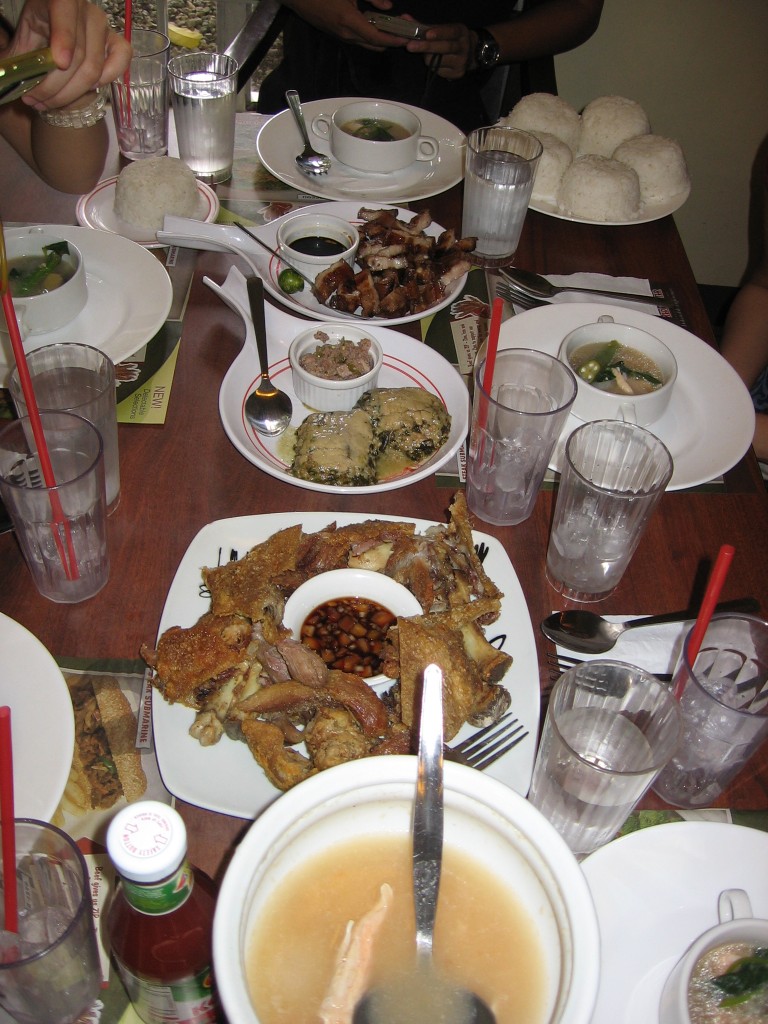As I am writing this post, it is raining. Typhoon Ramon hovers over Agusan and nearby provinces. Rain has a comforting effect on me that it makes me crave for food. We had arroz caldo for lunch and champorado for dinner. Nothing brings comfort than a hot bowl of goodness in this cold weather.
Now curled up in bed, the sound of spattering rain drones on. This “aircon” weather induces me into craving for Pinoy food. Since the recent trip is still fresh in my mind, I try to remember the texture, taste and smell of Bicol cuisine.
Food adds more joy to travel. Bicol is a delightful place to sample new dishes. Bicolanos have ingenious ways of creating memorable dishes from local ingredients like coconut, gabi leaves, malunggay, fish and sili. Pili nuts grown aplenty in this region and I found myself hoarding pili delicacies to bring to family back home.
My first stop to sampling Bicol food was Geewan. Geewan is a dining place in Naga where Bicolano food is served. My friend suggested that I go easy into incorporating a Bicol dish into our lunch so as not to shock my Bisayan palate. We picked kinunot to complement the sweet and sour meatballs and pork barbecue.
Kinunot is a fish dish cooked in coconut milk (gata) with malunggay leaves. It was pretty good and it set my taste buds on what to expect from Bicol food. My friend asked if it is made with shark meat, the server said no. Traditionally, kinunot is made with shark meat. I would not order this if this was shark meat. It would break my heart to eat endangered species.
One cannot visit Bicol and not taste Bicol express and laing. Those dishes are two of the more popular Bicolano creations. I can even take home a bottle or two. But alas! My promo ticket did not allow me to have checked-in luggage. I could not have it hand-carried either. The airports frown at liquid-y stuff. I even inquired if I can send the bottles thru courier but LBC said they don’t ship breakable items. I have to make the most out of our sumptuous lunch by making myself savor every bite ignoring the tightening of my waistline.
Laing is gabi leaves cooked in coconut milk the Bicolano way. It has a melt-in-your-mouth quality to it that perfectly complemented the crunch of the crispy pata we ordered. Bicol express, on the other hand, is meat cooked in coconut milk with chilli (sili). I have low tolerance for spicy food but, for some reason, Bicol express added a little kick to the grilled pork belly. It left a little heat on my mouth which was easily washed down with iced tea.
Merienda time called for toasted siopao. The tanned version of the siopao filled my hungry stomach with its compact bun yet surprising soft dough inside. This hearty and meaty snack easily satisfied my hunger pangs.
After all the touristy things we did, we were in search for a warm and comforting bowl of hot soup. Kinalas was the answer to our food craving. When in Bicol, one can easily find an eatery serving this dish. It is a noodle soup with vegetables and strips of soft beef in a flavorful broth. We choose the one with boiled egg added. Paired with puto and cold soda, I sipped the broth one spoonful at a time alternating it with bites of noodles and meat. The aroma filled my nostrils and beads of sweat appeared on my forehead-a sign of a good soup. It is hard not to smile after the meal.
 My travel companions are the sweetest. Before we left Bicol, my friends surprised me with a birthday cake even if it has been two weeks since my birthday! They bought a Concorde cake. Although the recipe did not originate from Bicol, a bakery there makes it their specialty that it was featured in the travel guide my friend was reading. True enough, the layers of meringue make the cake light and soft. The chocolate buttercream was a delight. The cake’s sweetness and mix of a pleasure in my mouth was a delightful way to cap off my whole Bicol experience.
My travel companions are the sweetest. Before we left Bicol, my friends surprised me with a birthday cake even if it has been two weeks since my birthday! They bought a Concorde cake. Although the recipe did not originate from Bicol, a bakery there makes it their specialty that it was featured in the travel guide my friend was reading. True enough, the layers of meringue make the cake light and soft. The chocolate buttercream was a delight. The cake’s sweetness and mix of a pleasure in my mouth was a delightful way to cap off my whole Bicol experience.





[…] It was the first time I traveled with friends. We had so much fun that we are planning another trip this year to another Philippine destination. There was so much to see in CamSur that I wrote 4 blog posts about this trip: here, here, here and here. […]
All the food in this entry are mouth-watering! More so, tasting a region’s food specialty is tantamount to experiencing a part of their culture.